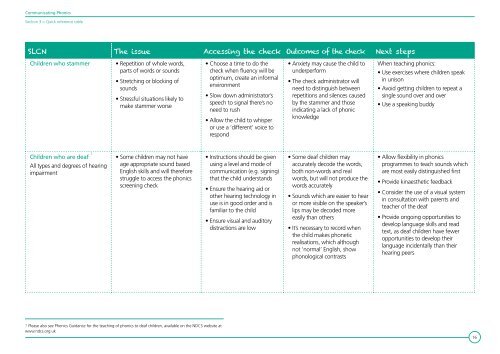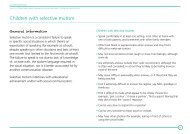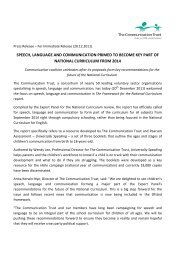Communicating Phonics - The Communication Trust
Communicating Phonics - The Communication Trust
Communicating Phonics - The Communication Trust
You also want an ePaper? Increase the reach of your titles
YUMPU automatically turns print PDFs into web optimized ePapers that Google loves.
<strong>Communicating</strong> <strong>Phonics</strong>Section 3 > Quick reference tableSLCN <strong>The</strong> issue Accessing the check Outcomes of the check Next stepsChildren who stammer• Repetition of whole words,parts of words or sounds• Stretching or blocking ofsounds• Stressful situations likely tomake stammer worse• Choose a time to do thecheck when fluency will beoptimum, create an informalenvironment• Slow down administrator’sspeech to signal there’s noneed to rush• Allow the child to whisperor use a ‘different’ voice torespond• Anxiety may cause the child tounderperform• <strong>The</strong> check administrator willneed to distinguish betweenrepetitions and silences causedby the stammer and thoseindicating a lack of phonicknowledgeWhen teaching phonics:• Use exercises where children speakin unison• Avoid getting children to repeat asingle sound over and over• Use a speaking buddyChildren who are deaf 7All types and degrees of hearingimpairment• Some children may not haveage appropriate sound basedEnglish skills and will thereforestruggle to access the phonicsscreening check• Instructions should be givenusing a level and mode ofcommunication (e.g. signing)that the child understands• Ensure the hearing aid orother hearing technology inuse is in good order and isfamiliar to the child• Ensure visual and auditorydistractions are low• Some deaf children mayaccurately decode the words,both non-words and realwords, but will not produce thewords accurately• Sounds which are easier to hearor more visible on the speaker’slips may be decoded moreeasily than others• It’s necessary to record whenthe child makes phoneticrealisations, which althoughnot ‘normal’ English, showphonological contrasts• Allow flexibility in phonicsprogrammes to teach sounds whichare most easily distinguished first• Provide kinaesthetic feedback• Consider the use of a visual systemin consultation with parents andteacher of the deaf• Provide ongoing opportunities todevelop language skills and readtext, as deaf children have feweropportunities to develop theirlanguage incidentally than theirhearing peers7 Please also see <strong>Phonics</strong> Guidance for the teaching of phonics to deaf children, available on the NDCS website atwww.ndcs.org.uk16
















